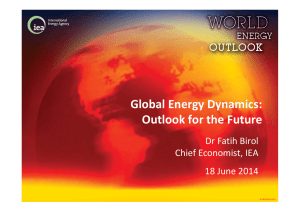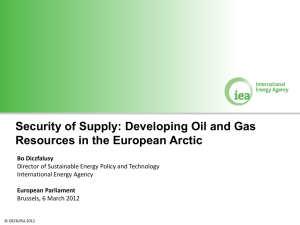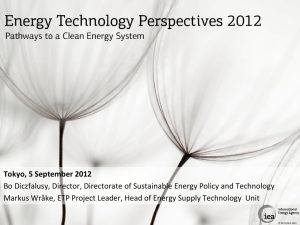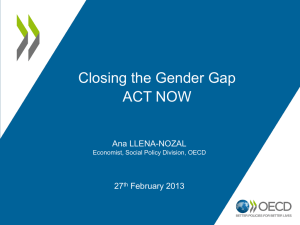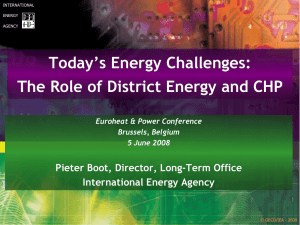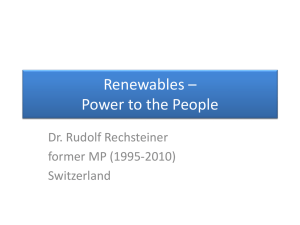Presentation of Anne-Sophie Corbeau, Gas Analyst, Energy
advertisement
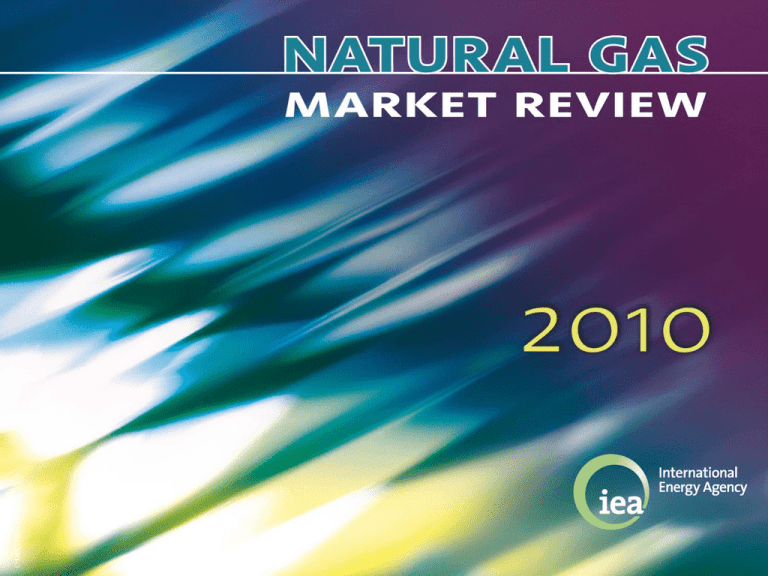
© OECD/IEA 2010 © OECD/IEA 2010 The current picture A global oversupply © OECD/IEA 2010 Gas oversupply Short and long-term consequences… Short-term consequences 2009-10 – Fundamentals • Demand is falling • Available supplies increasing: Unconventional gas + LNG • Spot prices twice as low as oillinked gas prices • Uncertainty on demand recovery and infrastructure investments • Difficulty to respect TOP • Decoupling between gas and oil prices? Long-term consequences • What is the role of gas in the energy mix? • Where should companies invest? • Gas glut or supply crunch? © OECD/IEA 2010 Gas market is not global But is certainly globalising New exporters New buyers © OECD/IEA 2010 OECD Gas Demand Some recovery at least? OECD -3.4%* Meanwhile China +11%* Source: IEA, Monthly Gas Data, *Preliminary data © OECD/IEA 2010 The drop was impressive in Europe © OECD/IEA 2010 Gas supply highlights OECD Production has been stable in 2009 -0.7% (+3% in 2008) Production increased in North America and Pacific But declined in Europe (except Norway) Non-OECD gas production more affected by the crisis Russian and Algerian output declined Turkmen production dropped significantly Production increased in Qatar, India; Yemen started producing Two major changes The unconventional gas revolution in the US The massive expansion of liquefaction capacity over 2008-13 Global surplus expected for the upcoming years © OECD/IEA 2010 Unconventional gas impact on the markets Growth of US unconventional gas has had regional and global consequences Regional Low utilization of the US LNG terminals – 9 bcm imported in 2008, 13 bcm in 2009 Lower imports of Canadian gas Change in investments: Kitimat LNG was changed from import to export Global Aggravation of the oversupply and therefore drop of spot prices More LNG available for the other markets Discourage LNG projects targeting the US: FIDs are unlikely in the Atlantic basin with the current market conditions All importing countries look at potential unconventional gas (Australia, Europe, China, India, Argentina, Indonesia) M&A at companies’ level © OECD/IEA 2010 LNG Markets A look back at 2009, what to expect for 2010 Problems are now common in new and existing liquefaction plants There was little growth of LNG trade in 2009 – by an estimated +5% Output has been improving only during the second half of 2009 LNG imports – a contrasted picture LNG imports in Japan and Korea declined by 7 and 9% respectively UK imports increased by more than 10 US LNG imports increased by 30% to 13 bcm China LNG imports increased by 66% to 7.5 bcm New players are appearing: Kuwait, Canada The year 2010 will see the actual ramp up of production All facilities will progressively increase output Peru and two last Qatari plants expected to start © OECD/IEA 2010 Massive new LNG supply in sight Despite a slow start, this LNG will arrive on markets… Source: IEA, NGMR 09 © OECD/IEA 2010 Price decoupling and convergence For how long? Some signs of spot indexation? A bump or NBP living its own life? © OECD/IEA 2010 Two different price systems coexist For how long? Divergence between spot and oil-indexed gas prices Spot prices half of oil based prices Convergence of spot prices Consequences Buying gas at spot volumes has been very attractive Pressure on long-term contracts to respect minimum TOP quantities Decoupling of gas prices? Renegotiations of some long-term contracts Gazprom Statoil GasTerra Have made “public” announcements © OECD/IEA 2010 Long-term view © OECD/IEA 2010 Long-term gas demand outlook Gas demand is growing in any scenario 41% in the reference scenario (WEO 2009) 17% in the 450 scenario Most of the growth comes from non-OECD countries China and India show the most impressive growth rates Middle East has the largest incremental growth OECD Europe gas demand would grow only by 0.8%/y over 2007-30 Demand is expected to slowly in the medium term Limited growth in OECD countries: back to 2007’s levels by 2014-15 Non-OECD countries gas demand grows by over 300 bcm between 2007 and 2030 But many uncertainties Economic recovery Gas demand from power generators © OECD/IEA 2010 tcm But investments in the upstream sector would still be needed 5 100% 4 80% Currently producing fields 3 60% Share from fields not yet producing (right axis) 2 40% 1 20% 0 0% 2007 2015 2020 2025 Fields yet to be developed or found 2030 Additional capacity of around 2 700 bcm, or 4 times current Russian capacity, is needed by 2030 – half to offset decline at existing fields & half to meet the increase in demand © OECD/IEA 2010 Gas oversupply The impact on infrastructure use bcm Use of interregional transport capacity (LHS) 900 100% 800 90% 700 80% 70% 600 60% 500 Unutilised capacity Total trade Capacity utilisation rate (right axis) 50% 400 40% 300 30% 200 20% 100 10% 0 0% 2007 2009 2011 2013 2015 2017 2019 Surplus of 200-250 bcm versus 60 bcm in 2007 (which was tight) But strong regional differences Pipelines less flexible, likely to be more affected And some “surplus” capacity is also desirable for security of supply reasons © OECD/IEA 2010 Can the US unconventional gas success story be reproduced elsewhere? The potential of unconventional resources is still poorly mapped and quantified Even in the United States Difficulty to apply the same methodology as for conventional gas Uncertainties on how much of this gas is actually recoverable? Some key success factors Identification of the location and potential of the best areas Availability of rigs and of engineers Acceptance by local communities, landowners Resolution of environmental issues (water management) Possibility to link to existing pipeline infrastructure Once some potential has been identified, population support and respect of environmental regulations will be key © OECD/IEA 2010 Recent developments By country Australia – the front runner Many CBM/CSM projects China, India, Indonesia looking seriously at it China, India already producing some CBM Ambitious targets for shale gas in China (15 to 30 bcm by 2030) Growing interest in Europe GASH initiative to evaluate potential Chevron, Exxon Mobil, ConocoPhillips and Marathon in Poland Shale gas potential in Sweden, France CBM in the UK But disappointment in Hungary (Exxon and MOL exit the Mako field) Potential in Latin America Argentina (Neuquén basin) © OECD/IEA 2010 © OECD/IEA 2010 © OECD/IEA 2010
